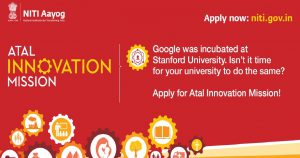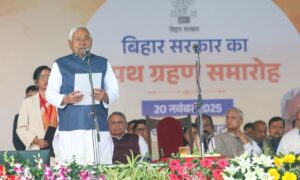
As the National Democratic Alliance (NDA) Government completed three years under the leadership of Narendra Modi – the Prime Minister of India (PM), Impact News in going to shed light on a much-touted mission – Atal Innovation Mission(AIM). Our focus will be on how AIM Works, what intents are and what challenges ahead are.
In 2014, the National Democratic Alliance (NDA) came into power after a decisive electoral mandate. In his maiden address from the rampart of Red Fort, PM announced to scrap the Planning Commission – a relic of the Soviet-style planning. After consultation with chief ministers, the Union Government replaced the Planning Commission with a new institution – the National Institution for Transforming India. It is popularly known as the NITI Aayog. This apex think tank is working on a wide range of policy issues. One of them is innovation (and entrepreneurship).
Presenting the General Budget 2015-16, the Union Finance Minister stated his intentions to establish the ATAL Innovation Mission (AIM) under the National Institution for Transforming India (NITI Aaayog). With an allocation of 150 core rupees in 2015-16, the AIM started its journey. As the Union Finance Minister stated, AIM will be an Innovation Promotion Platform which will engage academics, entrepreneurs, and researchers. Consistent with this objective, the Union Cabinet chaired by the Prime Minister Narendra Modi gave its approval for the establishment of AIM and Self Employment and Talent Utilisation (SETU) in NITI Aayog.
The AIM came with a set of initiatives to promote entrepreneurship and innovation in India.
The Core Functions of the Atal Innovation Mission:
Ø Entrepreneurship Promotion through the SETU
Ø Innovation Promotion
Components of Innovation Promotion:
Ø Scale-up support to Established Incubators
(Source: NITI Aayog)
Atal Tinkering Labs:
With a vision to ‘Cultivate one Million children in India as Neoteric Innovators, the Government came with an idea of the Atal Tinkering Lab under the AIM. According to the NITI Aayog, “ATL is a workspace where young minds can give shape to their ideas through hands-on do-it-yourself mode; and learn innovation skills. Young children will get a chance to work with tools and equipment to understand the concepts of STEM (Science, Technology, Engineering, and Math).”
As mentioned in the official document, AIM provides grant-in-aid that includes a one-time establishment cost of Rs. 10 lakh and operational expenses of Rs. 10 lakh for a maximum period of 5 years to each ATL. As mentioned, such schools (vi-xii) are managed by the government, local bodies and private trusts. (For More Detail on Guidelines).
According to the NITI Aayog, total 457 schools selected for establishing Atal Tinkering Laboratories in India. They presented a state-wise list but they did not mention the respective areas and districts. The total number of schools (Government, local bodies and private schools) applied for establishing Atal Tinkering Laboratories is 13005. The document mentioned that 748 Kendriya Vidyalaya and 142 Jawahar Navodaya Vidyalaya in India applied for Atal Tinkering Laboratories.
Going through the given detail, NITI Aayog accepted applications from these schools. But there is a clear indication that they are largely from the urban pockets.
If one will critically evaluate this mission, it is an attempt to encourage the student entrepreneurship in India. Writing in Indian Express, Professor Tarun Khana (Harvard University, USA) said that Tinkering Labs have potential to ignite entrepreneurship from the below. As usual, it is heartening to see that schools from the rural areas missed(or ignored) the bandwagon of the innovation promotion!
Atal Incubation Centers:
It is widely accepted and recognised that entrepreneurship is a tool to spur economic growth. To meet India’s aspiration as a future world leader, a concerted effort is a need in the domain of innovation and entrepreneurship. Apart from Atal Tinkering Labs, the innovation mission encourages to establish incubation centres in India. In Handbook for Non-Profit Incubator Managers of NITI Aayog, Wolfgang Leidig Director – Private Sector Development GIZ India stated, “Apart from challenges in access to capital, the current support, and incubation system is not sufficient to strengthen entrepreneurship in the country. Currently, there are around 220 incubators in India. Looking at the demand, incubation capacities need to increase to 1,000 incubators by the year 2020.”
In the wake of the AIM, setting up incubation centers in schools are not enough, there is an urgent need to address thorny issues if India really wants to become a start-up nation. These are:
Ø What measures are needed to inculcate innovation and entrepreneurial culture at the school level?
Ø In what ways, necessary skills for innovation and entrepreneurship should be inculcated in teachers at the school level?
Ø How teachers and schools from the rural areas can be encouraged and motivated to engage in such innovation activities under the AIM?
A Distant Dream:
As Times of India reported in 2016, A solitary teacher is running the show in as many as 1, 05,630 government elementary and secondary schools in the country, with MP emerging as the worst state where 17,874 of the institutions have just one teacher each. It is a staggering figure which paints a glooming picture of school education in India. In this backdrop, it is evident that a huge number of teachers is not equipped to teach and engage in innovation-centric projects. By training and qualification, they teach subjects like political science, Hindi, sociology, math, English, and science.
To fulfill the objective of the AIM, there is a need to address the above-mentioned issues. In this backdrop, various initiatives of AIMs should be percolated at the sub-state level. The government needs to invest more in schools from the rural India. Institutions from the top to the bottom must come together for creating a new knowledge at the intersections of existing disciplines. As of now, it seems a distant dream.


















